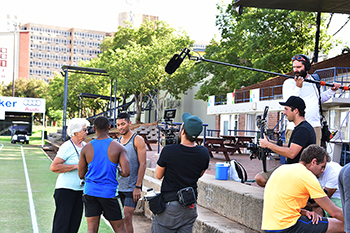Latest News Archive
Please select Category, Year, and then Month to display items
05 June 2018
Photo Supplied
 Archaeological excavations in the Wonderwerk Cave, north of Kuruman in the Northern Cape.
Archaeological excavations in the Wonderwerk Cave, north of Kuruman in the Northern Cape.
Research fellow Dr Lloyd Rossouw from the Department of Plant Sciences at the University of the Free State (UFS) recently published an article in the Nature Ecology and Evolution journal with Dr Michaela Ecker from the University of Toronto as lead author, and Dr James Brink, research fellow at the UFS Centre for Environmental Management. The findings described in “The palaeoecological context of the Oldowan-Acheulean in southern Africa” provides the first extensive paleoenvironmental sequence for the interior of southern Africa by applying a combination of methods for environmental reconstruction at Wonderwerk Cave, which have yielded multiple evidence of early human occupation dating back almost two million years ago.
Where water once was
The Wonderwerk Cave is found north of the Kuruman hills (situated in Northern Cape) a 140m long tube with a low ceiling. The surroundings are harsh. Semi-arid conditions allow for the survival of only hardy bushes, trees, and grasses. But during the Early Pleistocene, stepping out of the Wonderwerk Cave you would have been greeted by a completely different site, the researchers found. Using carbon and oxygen stable isotope analysis on the teeth of herbivores (Dr Ecker), fossil faunal abundance (Dr Brink), as well as the analysis of microscopic plant silica remains (phytoliths) excavated from fossil soils inside the cave (Dr Rossouw), the results show that ancient environments in the central interior of southern Africa were significantly wetter and housed a plant community unlike any other in the modern African savanna.
What difference does it make?
While East African research shows increasing aridity and the spread of summer-rainfall grasslands more than a million years ago, the results from this study indicate an interesting twist. During the same period, shifts in rainfall seasonality allowed for alternating summer and winter-rainfall grass occurrences coupled with prolonged wetlands, that remained major components of Early Pleistocene (more or less the period between one and two million years ago) environments in the central interior of southern Africa. That means our human ancestors were also living and evolving in environments other than the generally accepted open, arid grassland model.
NBC tells Wayde’s story
2015-11-02
 The film crew from NBC Olympics
filming Wayde van Niekerk (centre, in grey clothes)
during a practice session at Pellies Park on the
Bloemfontein Campus of the UFS.
On the left is Ans Botha, Van Niekerk’s coach.
Photo: Charl Devenish |
The Kovsie star Wayde van Niekerk stands an excellent chance of shining at the 2016 Olympics and has a remarkable story behind his success.
This is why NBC Olympics, a division of the American broadcasting network NBC, selected the athlete from the University of the Free State (UFS) to do a special insert for the Olympics in Rio de Janeiro.
A film crew from NBC visited the City of Roses and the Bloemfontein Campus of the UFS on Monday 26 and Tuesday 27 October 2015 to film the insert. The feature will be screened on NBC Olympics’ platforms during and leading up to the Olympics next year.
One of four stars
Van Niekerk was one of four athletes used by the crew to film inserts on. The others were the South African swimmer Chad le Clos, the Kenyan 800 m athlete David Rudisha, and Ethiopian middle- and long-distance athlete Genzebe Dibaba.
The crew interviewed Van Niekerk and his coach Ans Botha, and also paid a visit to Pellies Park during one of his training sessions.
According to Tom Davidson, feature producer at NBC Olympics, the piece about Van Niekerk will be about three minutes long.
“We do a pretty good job of picking good stories, but it is up to the athletes to get there,” Davidson said.
“We think Wayde has a good shot at being in the finals of the 400 m at the Olympics.”
Van Niekerk won a gold medal in a time of 43.48 s at the World Championships in Beijing during August 2015 and set a new South African record for a third time and a new African record for a second time this year in the process.
Beijing success propels Wayde onto NBC radar
“Wayde’s performance in Beijing certainly propelled him onto our radar,” said Davidson.
“He beat former World and Olympic champions like Kirani James and LaShawn Merritt.”
He feels that Van Niekerk is also very young and still at university.
And Botha makes his story even more interesting.
“It is not every day that you see a 74-year old great-grandmother coaching a world champion.”